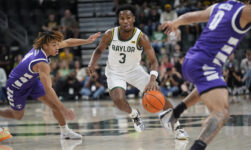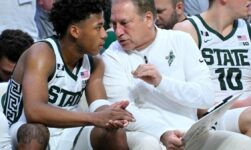In the wake of the Matthew Sluka brouhaha, one question started to ruminate: when will this come to college basketball? There’s always a trickle-down, and this snafu is no different. If the starting quarterback for an undefeated UNLV club can leave the team to preserve his redshirt amid an unprecedented NIL whodunit, then everything is on the table in this new era of college athletics.
“This is a lot more common than you think,” said Dan Poneman, who is hailed as one of the most influential NBA/NIL agents in the space. “Usually, players have to take it on the chin. This is the first time I’ve seen someone take a stand midseason.”
Money is the centerpiece of a relationship gone astray between Sluka and UNLV football. ESPN reported that Sluka was verbally promised a minimum of $100,000 from a UNLV assistant coach. Multiple sources told CBS Sports’ Matt Zenitz that Sluka had not received any NIL money from UNLV. A crux of the breakdown was the fact that whatever Sluka believed he was promised by UNLV was not outlined in writing before Sluka arrived as a coveted transfer from Holy Cross. One NIL agent told CBS Sports that Sluka’s camp or agent Marcus Cromartie not having an agreement in writing was “catastrophic.”
“It seems what has happened was there was a verbal promise to the agent and there would be a contract following when the kid got on campus and the contract never came,” Poneman says. “I’ve seen this happen. If that’s the case, I believe the player is in the right. I see people dragging the agent and I don’t think that’s fair. As an agent, it’s easy to sit on my high horse and go, ‘I’m the best, I would never do that.’ But the reality is, up until this year, collectives were not allowed to give contracts before players got on campus and even when that rule was changed, a lot of schools really dig their heels in and still insist that they won’t give out contracts until you get on campus.
“I have empathy for this agent who is getting dragged from people who don’t understand how NIL works, don’t understand the marketplace, don’t understand the Wild West-ness of this whole thing. He’s getting dragged for something a lot of agents have done. Of course, he wanted a contract before the kid got on campus, but the school wouldn’t provide it and then they pulled the rug out from under him, so the agent gave advice and the kid took it.”
Unfortunately, all contracts are not created equally and the money is rarely fully guaranteed. There are outs in every contract for off-court malfeasance (arrests, academically ineligible, kicked out of school, failed drug tests, etc), but the dirty little secret in college basketball and college football is that the money used at the negotiating table isn’t always actually there. Sometimes, it has to be fundraised. Sometimes, boosters can change their minds or take money off the table to try and force a coaching change.
“I think the biggest misconception is that there’s so much money out there,” said Marc Hsu, a former DePaul and Western Kentucky assistant who is now the VP for the agency Verus Basketball. “There’s not. There are a few schools that have a handful of money and it’s not what people think schools have. For example, one school is two million dollars over what they’ve committed to on that roster. They thought they were going to get donations from people, but it didn’t come in. There’s not all this money that everyone thinks.
“Most Power Five basketball collectives are between $2.5 and $4 million on the average. Do the math, if you have 13 scholarship guys, that’s about $300,000 each. Some guys get $600,000, some guys get $900,000. That’s not as much as everyone thinks is out there.”
Hsu noted that one of Verus Basketball’s clients did not receive the final six-figure payment until three months after the season ended.
“There’s a chance you’re not going to get the amount that you signed for,” Hsu says. “That’s a real possibility. Those last three months after Christmas? Whew. I know multiple kids last year that went to Big 12, Big Ten schools that still haven’t gotten paid because the collective ran out of money.”
Poneman has encountered numerous situations where some collectives are late to pay. One collective even filed for bankruptcy to avoid a lawsuit. It’s not uncommon where some players to get their full NIL paychecks thanks to a strong contract, but their teammates aren’t so lucky because the contract wasn’t as stiff.
“I always joke when collectives are like, ‘You don’t need an agent, we’re gonna do what we promised and get you every dollar,'” Poneman says. “Imagine an NBA general manager telling a player that. It would never happen. There’s no area in pro sports where the GM or the coach would tell the player don’t have representation. It’s a mechanism for taking advantage of players. There are a lot of guys who got verbal promises from collectives and got every penny, but there’s a lot of guys who got promises and got a fraction. It’s tragic. It’s exploitation.”
Poneman continued outlining sticky scenarios.
“Bad collective directors are the most dangerous thing to a success of a program. Imagine you’re a head coach at a high-major school, you’ve worked so hard to build relationships with agents, AAU coaches, players and build a reputation, and there’s some guy who you didn’t hire and has a big ego and he’s trying to battle agents over details that don’t matter. This guy is undermining the ability of the program to recruit top players. I’ve seen one collective where the top guy got fired because he was being such a pain in the ass to me. I’d had it. And they were like, ‘If you’re taking this power that we gave you and undermined our ability to recruit more great players in the future, then you’re doing more harm than good.'”
College basketball does not currently have a redshirt rule similar to football where a player can play up to four games and maintain their redshirt. That adds another wrinkle. Currently, if college basketball players play one second in a season, the redshirt is burned, barring an injury waiver. Purdue’s Matt Painter has long utilized the current redshirt rules to develop key players, but in the NIL era when maximizing your value is vital, some players choose to redshirt and save a year of eligibility if they believed their path to minutes was limited. Former Illinois guard Sencire Harris was a key, off-the-bench, sparkplug for the Illini in 2022-23 as a true freshman, but he opted to redshirt before his sophomore season tipped off. After the Illini’s run to the Elite Eight, Harris transferred to West Virginia where he’ll have three more years of eligibility. He followed new WVU assistant Chester Frazier, who recruited the defense-first guard to Champaign.
The NCAA is currently considering historic changes where basketball players could play up to 30% of a season before burning the redshirt. That could open the door for a Sluka-like fallout to come to fruition in basketball where a player opts to leave the team.
College basketball’s opening night is less than six weeks away. The rosters are set for now, but preseason practices will illuminate who will and won’t get minutes. Some promises won’t be kept. Feelings will, undoubtedly, be hurt, and that will lead to transfer portal rumblings.
Some payments unfortunately will not be made.
“I hear it very often,” Hsu said. “Usually it’s dads or moms that feel like they can do it by themselves. We have a pipeline of guys. We can hold collectives or staffs accountable versus a mom or a dad who they might not care if they burn that bridge because who is coming after them? No one.”
Sluka’s public spat with UNLV over finances is happening in college basketball behind the scenes. This level of after-effect just hasn’t happened. Yet.
Dennis Dodd, John Talty and Matt Zenitz contributed to this story.




